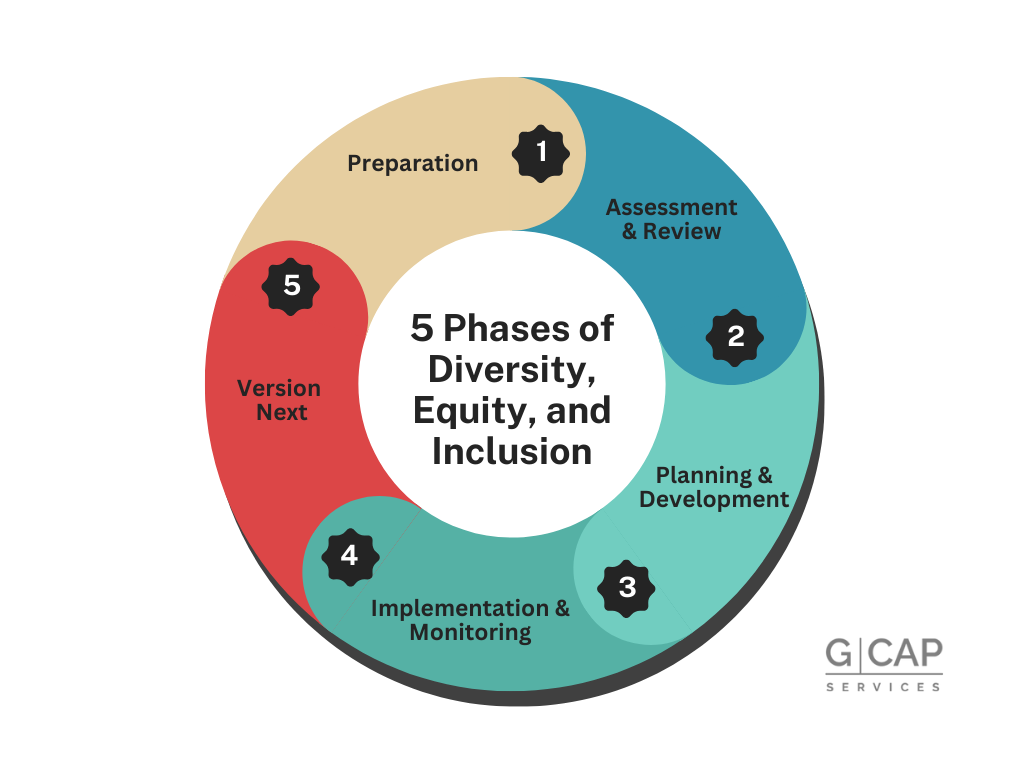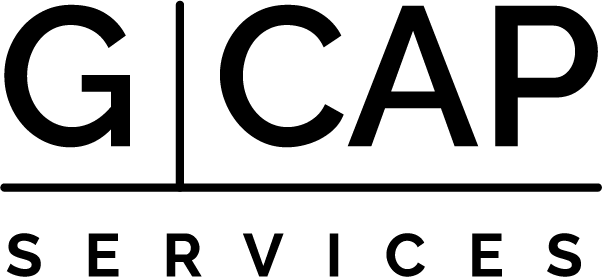How Federal Agencies Can Advance Equity through Executive Order 14091
June 23, 2023DBE Fraud Cases: A Timely Reminder to Prioritize Commercially Useful Function Reviews
September 20, 2023When it comes to diversity, equity, and inclusion, there is not a ‘one size fits all’ strategy and integration plan—each organization should have their own to address their uniquely identified needs. What works for one organization may or may not work for other. Therefore, assessing, monitoring, and adjusting the strategy is critical to the success of DEI programs.
Use this quick guide below to familiarize yourself with the 5 phases of DEI to help build your organization's strategy and integration plan and ensure its success:
Phase 1: Preparation
Get the conversation started! Gain buy-in from the senior leadership team and department leaders, and once they're on board, gain budget and headcount for the DEI engagement. Then, collect and share diversity data and metrics in areas where your organization is asking employees to self-identify. In the U.S., this typically includes race, gender, disability, and military veteran status, but will vary by country and region around the world. Basic training follows this and it helps builds a shared understanding for the basics of DEI across people leaders and all employees through an introductory DEI training. At a minimum, training should include definitions of diversity, equity, inclusion, intersectionality, accessibility, and understanding the difference between equity vs. equality. Bring all employees along on the journey to enhancing your organization with consistent and effective communication like executive and department leadership emails, newsletters, posters, and content on your organization’s intranet website.
Phase 2: Assessment & Review
Once things are in motion, it's time to look at data. Quantitative and qualitative assessments will help you understand where your organization is today and where it aspires to be. This data is foundational to understanding where the issues, challenges, and opportunities exist. Your benchmark assessment conveys your current state and will inform your DEI strategic plan. There are several quantitative and qualitative methods to accomplish this step.
Quantitative assessments are centered around workforce demographic data to be collected and analyzed at each step of the employee lifecycle—from job candidates (recruiting rates) to hires (hiring data) to workforce population (by job level representation) to promotions (promotion rates) to terminations (by employee [quit] and employer [fired]).
Qualitative assessments include executive one-to-one interviews, focus groups by demographic communities (e.g., Black, Women, Latine, and more), and utilizing Employee Resource Groups. Analyzing internal and external policies, practices, and programs through a DEI lens also helps to provide holistic information to inform organizational change.
Phase 3: Planning & Development
With ample data, you can now analyze the current state of DEI to understand and address gaps using data collected from the quantitative and qualitative assessments. Create your "gap plan" based on identified issues, challenges, and opportunities. Gap plans describe the current state of DEI at your organization and then explain the organization’s DEI aspirations using SMARTIE (Specific, Measurable, Achievable, Relevant, Timebound, Inclusive, and Equitable) goals. Once your gap plan is complete, communicate your findings and recommendations to leadership and all stakeholders and get their feedback. As the DEI Strategy and Integration Plan is developed, incorporating stakeholder feedback in the revised plan (as appropriate) is crucial to long term success. We recommend providing status updates regularly before distributing a finalized plan to all stakeholders. Your plan should detail your organization's shortcomings, a list of hurdles or challenges being faced, and how the DEI plan will address the hurdle or challenge with specific actionable steps to bridge the gap from current to future state.
Example:
-
As-is State: Frontline employees describe feelings of inequity and not being heard or appreciated by management.
-
To-be State: Employees at all levels feel heard, respected, and included and experience sense of belonging.
-
Actionable Steps: Implement one-to-one inclusive meetings and all-hands meetings that employ a rotation for meeting speakers to enhance participation and company culture.
Phase 4: Implementation and Monitoring
With a plan in place, it's time to put your DEI Strategy into action by determining who is responsible for each action and delineate what needs to get done and by when. Use measurable Key Performance Indicators (KPIs) and determine how the organization will track the performance on goals, too. We suggest creating an online website or Excel DEI Dashboard to track and report this progress. It is also critically important to align the DEI plan with the organization’s priorities and work with leadership to gain active and visible sponsorship for the plan. Ultimately, the DEI Strategy and Integration Plan is a business plan, and organizational leaders should take ownership for it in their business and be accountable for results in order to achieve its goals.
Phase 5: Version Next
Organizations experience change, growth, and a need for adjustment, so on a regular basis, quarterly or bi-annually, it is important to continuously assess your DEI initiatives. As you implement, there will be learning opportunities for everyone. Adjust and pivot as needed to ensure the goals and programs remain relevant and achieve the intended impact. Be sure to have your antennae up with various listening tools, (e.g., surveys, interviews, discussions, and more) to gather and integrate stakeholder feedback and input.
Remember that not all DEI ‘recipes’ are the same. DEI is not a check box activity so don’t expect overnight change; DEI is a journey—not a destination. Do what works for your organization and aligns strategically with priorities and goals that serve everyone.

About the Authors
GCAP provides an array of DEI consulting and training services to help organizations be their best. Visit our website to learn more or complete this form to connect with our Business Development team to discuss opportunities.
